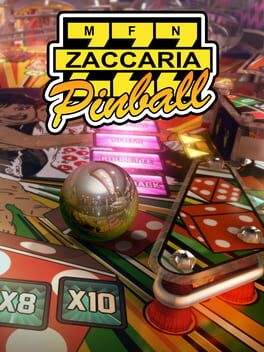Zaccaria Pinball is a game focused on emulating the tables of the Italian pinball company Zaccaria, with an emphasis on strong physics simulation. Zaccaria produced pinball tables from 1974 to 1987, and was one of the most successful manufacturers of its time. The pinball tables they engineered were made to the standards of their time—while they can be fun to play, the strength of their layouts and gameplay styles vary greatly, and they lack the design sensibilities of modern tables. For example, many of the older tables have greedy outlanes or a large amount of space between the flippers, which can easily cause balls to sink instantly without player error. Combine that with the fact that starting with a ball saver didn't become common until the '90s, and you have a lot of wasted quarters. To give another, but somewhat different example, old people sure did love to slap Native American stereotypes on everything and call it a "theme." All of that, minus the quarters, carries over into Zaccaria Pinball. Magic Pixel's newly-designed tables, many of which are Zaccaria tables reimagined to be from different eras, also tend to follow these design principles. The result is that we have cool and accurate digital representations of these real tables, preserved in our computers so their legacies can live on. When it comes to playing these classics, however, we end up with a few great and fun tables, a few too many godawful tables, and a good majority that are decent, if dated. To be fair, however, there's a whole section dedicated to modernized versions of classic tables, and these tend to be the most fun for me. Many of them are designed extremely well, and feel great to play.
As far as the program's actual features go, Magic Pixel does a pretty solid job. The ball simulation is fantastic, especially on simulation mode—the other main option being arcade mode, which makes the ball a bit slower and more "video gamey." While the menu and UI leaves a lot to be desired, the actual tables look great and there are a lot of settings players can adjust to their liking, including lighting, reflections, glass visibility, weather conditions outside the window, and more. Speaking of weather conditions, players can change the environment surrounding the table itself. The room can be spruced up with decorations, but they're not particularly appealing—yes, you must have an ugly statue on your ugly console table. It's all very '70s and '80s, which I assume is meant to match the time period of the tables, but it feels like a wasted opportunity. It's all well-made, and looks great in VR (which is a stupid DLC purchase), but the option to have more modern surroundings would have been nice as well. Audio depends largely on the table. Bumpers and slingshots and whatnot tend to sound great and punchy, though by this point I've just turned the announcer voice off due to how incessant and annoying they can be.
Ultimately, it's worth checking out. The program itself is free, the physics are great, it comes with a few tables, and players can always buy more if they feel like the DLC is worth the price. Just be aware that when buying packs, there may be just a few stand-out tables.
As far as the program's actual features go, Magic Pixel does a pretty solid job. The ball simulation is fantastic, especially on simulation mode—the other main option being arcade mode, which makes the ball a bit slower and more "video gamey." While the menu and UI leaves a lot to be desired, the actual tables look great and there are a lot of settings players can adjust to their liking, including lighting, reflections, glass visibility, weather conditions outside the window, and more. Speaking of weather conditions, players can change the environment surrounding the table itself. The room can be spruced up with decorations, but they're not particularly appealing—yes, you must have an ugly statue on your ugly console table. It's all very '70s and '80s, which I assume is meant to match the time period of the tables, but it feels like a wasted opportunity. It's all well-made, and looks great in VR (which is a stupid DLC purchase), but the option to have more modern surroundings would have been nice as well. Audio depends largely on the table. Bumpers and slingshots and whatnot tend to sound great and punchy, though by this point I've just turned the announcer voice off due to how incessant and annoying they can be.
Ultimately, it's worth checking out. The program itself is free, the physics are great, it comes with a few tables, and players can always buy more if they feel like the DLC is worth the price. Just be aware that when buying packs, there may be just a few stand-out tables.
